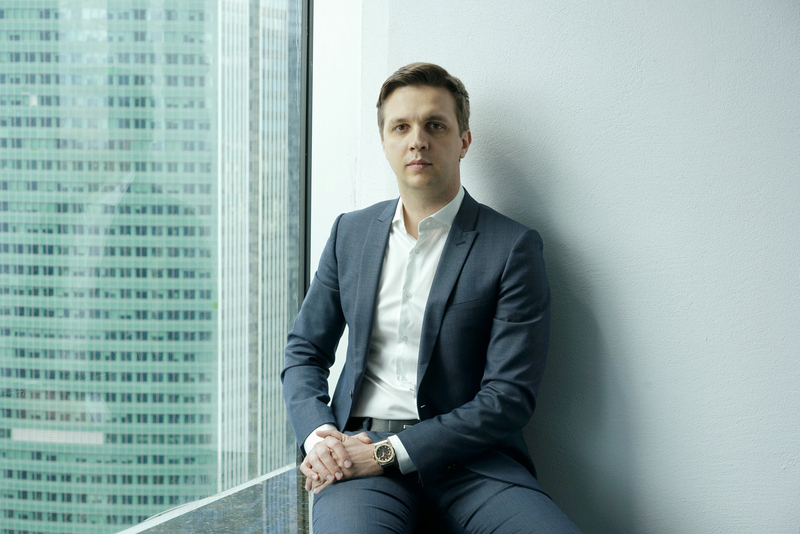
We talked to Grigorii Trubkin, the venture capitalist and managing partner of Mindrock Capital, about the impact of Brexit on the British market, the investment opportunities of space flight and trends on the fintech start-up market.

To support their economies, the governments of many countries have turned on the printing presses, as they understand that this will boost consumer demand and that inflation is inevitable in any case. This measure has had some unintended consequences, for example, the capitalisation of American companies has increased. Why is this?
Markets don’t like uncertainty. During covid, governments experienced what the Germans call Zeitnot, (‘time pressure’), as they were forced to take drastic decisions without time for adequate planning. For the first time, the economy as a whole was shut down, rather than just isolated sectors. The natural reaction of the market to this uncertainty is always to sell, jettisoning high risk assets first of all. All the indices slumped. The best thing state planners could come up with was to turn on the printing presses to increase the money supply in circulation and to start buying back devalued assets.
Inflation occurs due to two factors: the volume of the money supply and the speed of its circulation. That’s why economies were shut down and whole industries were put into ‘sleep mode’ (IT was an exception, as this sector actively grew). The speed of circulation, even at large volumes, was rather low. Inflation has already started to accelerate, people have started to spend money, most obviously in the US but soon it will start everywhere, it’s inevitable. Now they have put out the fire on the markets they’ve started to buy shares and move away from low risk investments, which is rather unsurprising.
Before the pandemic, it was a good rule to keep a volume of investment in fixed income instruments equal to your age. For example, I’m 32 and so 32% of my capital should be in bonds, while I can take risks with the remainder of my capital as I attempt to increase my revenue. Now, however, we’ve reached a turning point. Key interest rates at all central banks are at zero, and consequently, the cost of conservative instruments with fixed incomes are at a maximum. As the key rates begin to rise, the value of these instruments will fall. As a result, when investing in obligations, which are usually considered a reliable store of value, you must first offset the increase in inflation to at the very least break even. And that’s not enough; you need to find other ways to make money as well. That’s why there are no obligations in my portfolio, and I imagine that many other investors are acting in the same way.
What should we invest in to protect ourselves from inflation?
In my opinion, retail chains such as Walgreens and Walmart are currently good investments, because people will continue to buy groceries and other essentials no matter how high inflation becomes. Chain stores are seeing an increase in the size of the average spend. This means their revenue will rise and as a consequence, so will their profits. Investing in these companies instead of bonds provides some degree of security against inflation. Choosing to make no investments at the moment is also a risk. When inflation is 5% a year, this passive behaviour leads to a reduction in savings equal to the level of inflation. The possibility of inflation significantly exceeding 5% cannot be excluded, at least in the short term. To earn extra income you have to take risks, invest in innovation, start-ups, the creation of new markets and in companies whose growth rates can outpace inflation.
Why are shares in Virgin Galactic down since Richard Branson got back from space? How much potential is there in investing in the space industry?
First of all, before the flight, the market was in expectation. While Branson was preparing for launch-off, investors were placing bets on whether or not his technology would work. When the flight was successful, their attention shifted from ephemeral positive feelings to the question of how the project could be made into a commercial success. Despite the fact that quite a lot of tourists had pre-purchased tickets at $250,000 a seat, others had only paid a deposit of $1,000, and it’s not clear if they’ll pay the rest of the sum. Secondly, immediately after the flight, Branson announced the additional issue of half a billion dollars worth of shares, which weakened existing investors’ stakes in the company. A combination of these two factors lead to the fall in share value.
However, Jeff Bezos’s successful flight shows that there is another similar business model which seems to work. Moreover, Bezos flew higher, and on the intuitive level of investors’ perceptions, ‘higher means better’. This fact caused shares in Virgin Galactic to fall further. Neither of these projects are leaders in the field, although they are the closest anybody in space tourism has got to reaching the mass market.
Elon Musk’s SpaceX are the leaders in the space industry as a whole. They have shown that rocket flight delivering cargo and passengers into higher orbits can be fairly affordable. The main issue to be solved to allow the development of the space business is the question of the cost of cargo delivery. As rockets’ capacity grows, the price falls and Earth to Space delivery businesses will start to appear, as well as companies offering ‘space to space’ delivery. These will aim to support and accompany commercial activity off Earth. There are already plans for space hotels which will need to be transported from place to place and be supplied with water, oxygen and food. Incidentally, one of the start-ups we’ve invested in is called Momentus Space. They tow satellites and other objects into different orbits. This is an example of the kind of businesses which will appear in the future.
This sector has potential for investment, there is demand, but the risks are high. Some companies, such as Momentus Space, use existing technology, whereas others seem fantastic, as they rely on tech that is yet to be developed. An example is a start-up that proposes to mine platinum from asteroids as they fly past the Earth. Looking at the current state of technological development, it might be possible to do this in about ten years.
Brexit is finally done. What’s happening to the pound and how has leaving the EU affected companies’ capitalisation? What makes British start-ups stand out and what’s the situation on the venture capital market?
Brexit created uncertainty, which, as I said, the market doesn’t like. It wasn’t clear if London would keep its position as a financial centre, nor what the terms would be of any new trade agreements, especially with the eurozone. However, as foreign trade relations have recovered, the exchange rate of the pound to the euro has begun to stabilise. If we analyse the interplay between the pound and the euro over the last five years, then we can see that the relationship has been heavily influenced by stories in the news and by trade agreements, which lead to short term fluctuations in movements on the market.
If we evaluate the British economy using the FTSE 100 index, we can see that during covid, it went down, like all the others, however other markets, including Russia, have not just returned to their pre-covid levels, they’ve actually exceeded them (American indices are up 30% on pre-pandemic levels, and the NASDAQ tech index has doubled). Meanwhile, in Britain, the average capitalisation index of all British companies has still not regained its pre-covid level. On the one hand these evaluations may be too low. Perhaps the market is undervalued. On the other hand, companies’ value and growth may be stymied until investors have a better picture of which sectors are the ‘winners’ of Brexit and which have suffered heavy losses. The reopening of borders and air routes will also have an effect on growth.
Of all markets outside the US, Britain was the most suitable environment for the creation of start-ups. It provided a standard in service functions, a tolerance of mistakes as well as access to funds. In Europe it is quite hard to register a company and conduct operations. British start-ups achieved the greatest success in the sphere of fintech, which is clearly illustrated by the valuation of the company Revolut at $ 33 billion. For comparison, the capitalisation of Stripe, one of the most expensive American fintech start-ups, was valued at $ 95 billion. This is three times larger, not ten times or more. This is to say that in the sphere of infrastructure creation, Britain used to enjoy great success.
But whether it was launched in the States or over here, the first thing to consider is who exactly was responsible for the startup. The fact that it was incorporated in the UK isn’t so important. For startups, what’s important isn’t loans and other preferential treatment, but to be allowed to grow without excessive regulation. This is what investors value.
How are Russian startups different? Are foreign investors ready to fund them?
It’s important to note that just because a startup has been successful on the domestic market this does not guarantee that it will also do well abroad. A project’s chances of success are dictated by the specifics of the Russian economy, which is largely dominated by heavy industry and raw material extraction. (With the exception of some IT giants, which are large by Russian standards such as Sber, Yandex and the Mail.ru Group). Most startups are focused on innovation in specific industries. For example, a startup that modernises ore extraction at Norilsk Nickel [the world's largest producer of refined nickel], is unlikely to be able to adapt its technology to other mining companies as every company has its own equipment and its own methods of doing business.
Another problem for startups incorporated in Russia is the absence of competition amongst potential buyers. For example, if a startup goes on sale and there are two investors ready to acquire it, the business might be sold for quite a large sum. If one of these investors leaves the equation, the one that remains has absolute power over the founders of the startup, so they can offer a lower price. This common situation is bad for Russian startups.
To improve work with foreign investors, the state has to work on its reputation and give these investors a little more freedom to invest in startups which have been incorporated in Russia.
What questions do venture capitalists ask when they are offered a startup?
The standard questions. The first thing we need to understand is the personality of the founder. Why are they in this business? What’s the backstory to the project? It may be that everything has just gone well by chance and now the founder wants to quickly find a strategist and sell out. Or maybe this business is the founder’s calling, which they want to take to the global level through passion and hard work.
The second thing to look at is the business model. Amongst investors there is always a certain consensus about which sectors should be developed and how this should be done. For example, there is currently a trend for green energy, so if a startup appears which proposes to reduce tenfold coal consumption for a steam engine, this would go against the trend. And so, even if the startup could save those who use coal a great deal of money, no one is likely to invest in it. We only choose startups in sectors that we want to develop. If it’s a sector that we understand poorly, we won’t invest in it. We’ll send the entrepreneur to our partners, or to coinvestors who have more expertise in the specific sector.
If we’re happy about the founder and the business model, the next thing we look at is the stage of development the startup has reached, and how it stands out from other actors on the market. After that, we investigate the company’s prospective market. If it is smaller than $10 billion, most likely we won’t invest in it. It doesn't matter if the market for the startup already exists, or whether it remains to be created, we’ll evaluate it. If we find issues, either with the founder, or the business model, it may still be possible that we are looking at the next Facebook, however, it may also be the case that the problems we have found don’t need to be solved. (At this point it’s worth having a look at the so-called ‘startup cemetery’, where we can see who has already tried similar ideas and what came of it). This is why it’s good for startups to have competitors as it helps to confirm our hypotheses. If the startup’s target market is too large, it’s highly probable that the product has not been fully thought through, and there isn’t a clear understanding of who will want it. The target segment must be defined as clearly as possible. This is probably the main question that we ask startup founders.
In your opinion, what technological solutions will be in greatest demand for investment in the next 5 to ten years, and why?
All trends on the market develop in waves. Over time, the tempo has been increasing. Previously, in the epoch when social media sites were being born, waves lasted quite a long time. Now they change every three years. In five years or so we can expect a new wave to appear every year.
One of the most important trends today is increasing decentralisation which is powered by blockchain technology. The idea became popular in 2018, but now we can see its practical application. It allows smart contracts to use cryptocurrencies to cut intermediaries out of financial transactions. The fintech industry is flourishing. An important factor is that conventional banks are currently toughening up their procedures. This means even opening a basic bank account has become a problem for many people. Revolut and other online banks experienced a surge in custom after they simplified the process of opening an account and transferring money between ordinary people. Democratisation in this sphere will continue further.
Medicine has emerged as another large sector. There has been a lot of growth in biotechnology, genetic engineering and personalised medicine. Many different types of implants have been developed. Neuralink, for instance. This has demonstrated that it is possible to connect artificial intelligence to the human brain. With this technology, we are moving towards the ability to communicate with computers at the speed of thought.
Artificial Intelligence (AI) is also in use in space technology. Soon its use will become essential for the development of any sphere of business. In the AI sector, there is currently demand for companies which are able to gather data, find patterns, make predictions and draw insights. These companies are taking over the market as it’s hard to compete with them. Startups in new industries are trying to replicate the success of Facebook and Amazon. For example, People.ai is for sales management, Trax Retail is aimed at retail and FiscalNote makes predictions about how various legislation will affect business…but there are many potential niches.
There are many waves of innovation, which can overlap and crossover into different industries.
Trends arrive on the market from 6 to 12 months before they are picked up on, even by the business press. This is because these movements are not always noticeable when they have just appeared. Also, this delay allows investors to focus on the business in hand without the distraction of unnecessary information.
Elena Nedelya






